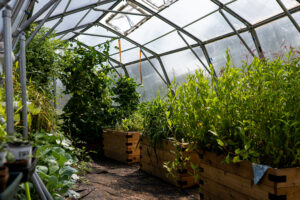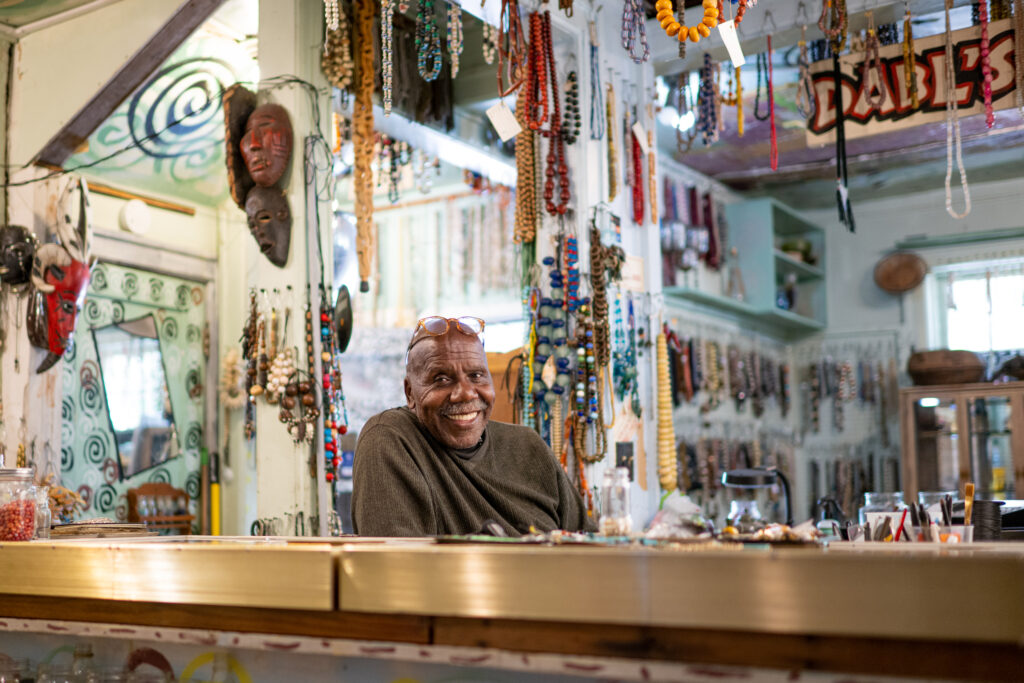Source: Special to Michigan News
Photos By: Eric Bronson, Michigan Photography
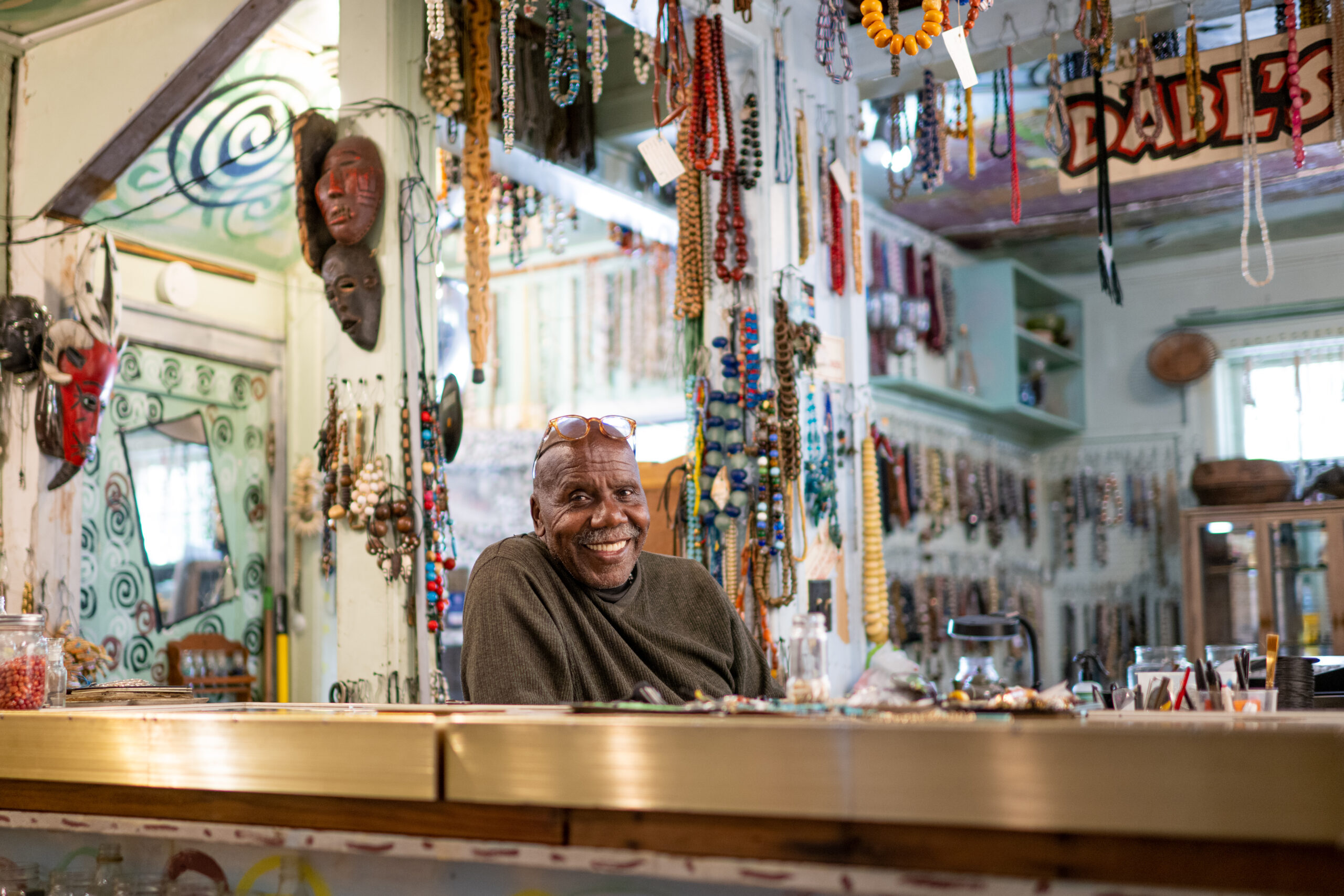
Museum founder Olayami Dabls.

Dabls Mbad African Bead Museum in Northwest Detroit.
Colorful designs painted on the brick building are the first thing you notice when approaching the Dabls Mbad African Bead Museum. An adjoining sculpture garden catches your eye next, with large-scale installations made of four materials central to the African diaspora: iron, rocks, wood, and mirrors.
Museum founder Olayami Dabls, an artist and storyteller who grew up in Detroit, wanted the museum’s exterior to tell the same story as the strands and jars of colorful beads displayed inside. Since 1998, the African Bead Museum has drawn visitors from around the world to its nontraditional approach to educating people on African material culture. Instead of offering placards describing the beads’ historical context, Dabls wants people to experience the beads as standalone items, drawing on their ancestral memory to make connections.
“The emphasis is placed more on looking at artifacts as opposed to trying to educate through words,” Dabls said. “The way African material culture worked, items communicate with the person through triggers that were placed in a particular culture that person was involved with. Whatever they go away with, that’s the experience.”
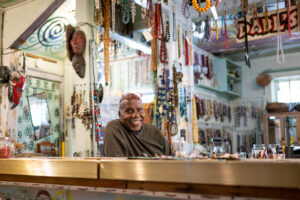
Museum founder Olayami Dabls.
The newest addition to the museum grounds – an AfricanFuturist Greenhouse that opened in April – builds on this theme to marry elements of ancient African culture with modern urban agriculture. Designed by University of Michigan faculty Ron Eglash and Audrey Bennett with a team of local and U-M students, the solar-powered greenhouse is shaped in a circular, scaling pattern typical of African design. Inside, the greenhouse uses automated systems to maintain an environment favorable for growing plants associated with the African diaspora, including Job’s Tears plants that produce seeds that can be used as beads, sweetgrass for weaving baskets, and food like greens.
Introduce us to the Dabls Mbad African Bead Museum. What was your original concept for the museum and how has it evolved over the years?
Dabls: I needed something to get people interested in African material culture, and I found beads to be the best thing to use. … Most of the people will come in here from other countries. It was fascinating to realize that people are interested in their ancestral memory and have the recollection about the use of beads traditionally. Also, I’ve tried to place less emphasis on a particular culture group and (instead) highlight general times and say ‘these beads were used by this group of people in this area’ and just allow that to be enough. And in doing that, what I’ve discovered is that most people don’t need a lot of information to make them comfortable about having a knowledge of themselves and their place here on the planet.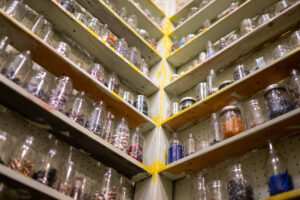
Our popularity is growing; it’s not diminishing. I thought by now, people would no longer be interested in the African Bead Museum and their approach that looks like they’ve gone against all the rules that were established to govern displaying and talking about artifacts. But it’s just the opposite. We’re living in a time when people are more open to accept ideas and concepts that normally they would not.
How did you get connected with the University of Michigan? Can you share an example of a project you worked on together?
Dabls: Ron Eglash came here a few years before the idea about the greenhouse popped up. He noticed that … this whole place is based on patterns; the same patterns, the same symbols are used, just larger or smaller. He recognized that immediately, and then he came back and said ‘I have a program that ties in with the beads.’ Detroit is a food desert. His idea was to grow your own food that also would have been used by the ancestors. When Ron said he wanted to do the greenhouse program, it was a hell of a pat on the back. He wanted to design a greenhouse that kind of mimicked some of the bead patterns. The greenhouse looks organic. It fits here. I can’t think of anywhere else in the city that what he’s doing would fit. It ties in with the rest of the community. It’s primitive but state of the art. … Just the idea to have the greenhouse in the community with this installation, which are years apart in terms of design. You’re talking about a state-of-the-art greenhouse and recycled wood, rocks, and mirrors, and it makes for a nice mix and people enjoy seeing it. It’s combining state-of-the-art technology with the behaviors that our ancestors used.

AfricanFuturist Greenhouse
What did you value most about your partnership with U-M?
Dabls: It’s the fact that it’s not occurred anywhere else. It supports one of my theories: if you want to move forward, you’ve got to look back. … The greenhouse is educational, yet it’s not in your face. It’s history and it’s not in your face. It’s culture. It’s agriculture and answers some of the needs of a food desert.
What advice would you give other organizations considering partnering with U-M?
Dabls: They should – why not? It’s state-of-the-art technology, and they’re willing to work with you in the community. It is always good to work with universities who want to do things in the community and are paying attention to what the community needs. When Ron came, he made a suggestion. I’ve gotten so much out of this. I’ve gotten notoriety, and people coming here really appreciate going into the greenhouse. They get to see these amazing plants growing the way they’re growing. It’s a whole different experience I never would have been exposed to. A whole lot of things I needed that I did not know I needed came with the greenhouse. I’ve been introduced to a whole different audience. It brings status.
